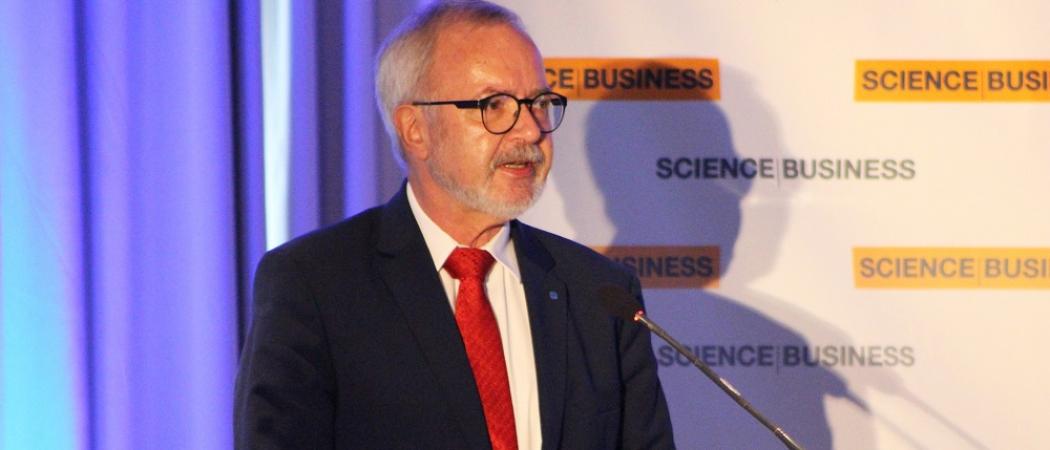After ten long years, the European economy has recovered from the crash. Now it is time to power ahead by boosting investment, says Werner Hoyer at a Science|Business conference

Courageous policy decisions since 2012 have helped Europe’s economy get back on track, with member states, the Commission and, of course, the European Central Bank working closely together to stimulate growth and employment.
As a result, investment is almost back to where it was before the crisis, helped in part also by investment initiatives such as European Commission president Jean-Claude Juncker’s Investment Plan for Europe, conceived, structured and implemented by the European Investment Bank (EIB).
But a slowdown in growth rates earlier this year, compounded by political headwinds in some member states, reminds us there is still unfinished business from the crisis years.
Investment gaps
The recovery - and last year’s surprisingly strong growth - are thin veils, obscuring the flaws in our growth story. Here are the three most obvious problems:
First, investment recovery has mainly been driven by the private sector. While public sector restraint in spending was necessary to bring public budgets back into balance, investment remains subdued, following a decade of sub-par investments in infrastructure and education, as well as research and innovation.
Second, instead of growing closer together, European economies continue to diverge, both between and within member states. Growth remains unbalanced. A key indicator here is youth unemployment, which has remained stubbornly high in many member states, mostly in the south.
Third – and for me this is the point - Europe increasingly fails to keep pace with our competitors in North America and Asia. The productivity gap that opened up in the early 2000s has become bigger.
The scale of the challenge is daunting. To catch up, we need to lift investment in innovation – R&D, digitalisation of our economy and education – by about €300 billion per year. Around two thirds of this will have to come from the private sector. The gap is particularly acute for so called “deep-tech’’ companies, found at the junction between science, research, engineering and data that are often characterised by high capital intensity, long development cycles and high technology risk.
To scale up, these companies need lots of patient capital that comes in earlier and stays longer than is currently on offer in Europe. As we have seen time and time again, if these promising deep tech companies fail to raise capital here, they leave Europe, most often heading to join a public market in the US.
Missing small innovators
The EIB’s investment survey, based on feedback from 12,000 companies across Europe, identified a specific problem. We discovered that large firms are twice as likely as SMEs to be innovators. And innovative young firms are 50 per cent more likely than other firms to be credit constrained.
The big failure in Europe at the moment is that even when a small company has an innovative idea, it is phenomenally hard for it to become a large innovator. We have large, old innovators, but we lack the Googles and Amazons.
The lack of scale-up funding to grow companies in key innovative sectors is mostly due to the limited amount of risk capital in Europe, the general risk-aversion of the European investor community and the fragmentation and lack of depth of our capital markets. This leaves few opportunities for healthy and innovative European companies to grow at critical stages of their development, and prevents Europe from reaping the benefits and enjoying the financial and societal returns on its investments, both public and private, in research and technology.
This has become a real issue that is holding Europe back. For this reason, I very much welcome the Commission’s proposal that the budget for Horizon Europe in the next multi-annual financial framework should increase to about €100 billion. It is also why we fully support the formation of the European Innovation Council (EIC) to back breakthrough innovation based on the same principle of excellence that the European Research Council has stamped on basic research. Currently, our advisory services are working closely with Commission counterparts in DG RTD on setting up of the EIC and in the design of its instruments.
Multiplying, mobilising, recycling
Still, much more funding would be needed. The way to raise this is in a smart combination of public and private money. The basic idea is simple: a small amount of public funds earmarked for science, research and innovation is used as a backstop – technically a guarantee – for equity and debt financing of investments in innovation.
Public funds that would otherwise be disbursed once in a grant, are instead deployed as risk capital in a fund that draws in additional financing from private investors.
The fund is revolving. That means repayments of the principal, plus returns through interest or equity participations, are high enough to compensate for the expected losses from defaults, allowing the investment to be effectively recycled. This experience of joint risk-sharing financial instruments between the Commission and the EIB has demonstrated the concept works - not just in principle, but also in practice.
The Risk-Sharing Finance Facility, the first of the financial instruments dedicated to R&D and innovation, supported investments of more than €30 billion with only €1 billion from the EU budget, plus €1 billion from the EIB.
Since its inception in 2015, the European Fund for Strategic Investments has underpinned about €100 billion of investment in R&D, innovation and digitalisation – more than a third of all its investments supported. The multiplier effect is close to an expected factor of 15. In other words, the EIB has converted €6.7 billion of EU guarantee into financing that has allowed projects with a total volume of €100 billion to go ahead.
These aggregate figures grew out of hundreds of individual investments, each of which is a fascinating piece of evidence that Europe could be amongst the world’s leaders in innovation, if we give our scientists, engineers and entrepreneurs the breathing space they need. By that, of course, I really mean the funding they need.
Science, research and innovation have historically been the main engines of wealth creation. Given the breathtaking pace of digitalisation, advances in life sciences and materials, their importance as drivers of productivity growth is unlikely to diminish in future. Europe needs determination to seize the opportunities that this age of technology offers.
Adapted from the keynote speech at the Science|Business Framework conference “Innovative Europe? Time for a new EU innovation strategy” in Brussels on June 4th 2018.





 A unique international forum for public research organisations and companies to connect their external engagement with strategic interests around their R&D system.
A unique international forum for public research organisations and companies to connect their external engagement with strategic interests around their R&D system.